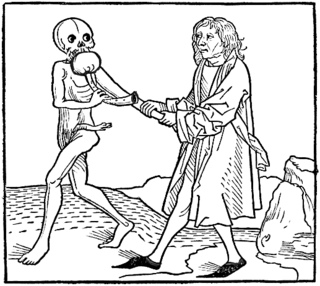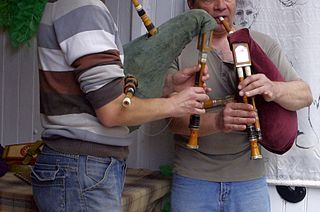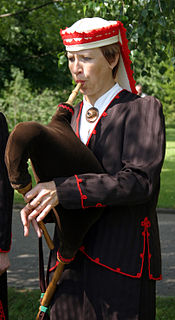Related Research Articles

Bagpipes are a woodwind instrument using enclosed reeds fed from a constant reservoir of air in the form of a bag. The Scottish Great Highland bagpipes are the best known examples in the Anglophone world, but people have played bagpipes for centuries throughout large parts of Europe, northern Africa, and western Asia, including Anatolia, the Caucasus, and around the Persian Gulf.

The uilleann pipes are the characteristic national bagpipe of Ireland. Earlier known in English as "union pipes", their current name is a partial translation of the Irish-language term píobaí uilleann, from their method of inflation. There is no historical record of the name or use of the term uilleann pipes before the twentieth century. It was an invention of Grattan Flood and the name stuck. People mistook the term 'union' to refer to the 1800 Act of Union; this is incorrect as Breandán Breathnach points out that a poem published in 1796 uses the term 'union'.

The chanter is the part of the bagpipe upon which the player creates the melody. It consists of a number of finger-holes, and in its simpler forms looks similar to a recorder. On more elaborate bagpipes, such as the Northumbrian bagpipes or the Uilleann pipes, it also may have a number of keys, to increase the instrument's range and/or the number of keys it can play in. Like the rest of the bagpipe, they are often decorated with a variety of substances, including metal (silver/nickel/gold/brass), bone, ivory, or plastic mountings.

The Great Highland bagpipe is a type of bagpipe native to Scotland. It has acquired widespread recognition through its usage in the British military and in pipe bands throughout the world.

The Galician gaita is the traditional instrument of Galicia and northern Portugal.

The Northumbrian smallpipes are bellows-blown bagpipes from North East England, where they have been an important factor in the local musical culture for more than 200 years. The family of the Duke of Northumberland have had an official piper for over 250 years, and in more recent times the Mayor of Gateshead and the Lord Mayor of Newcastle have both re-established the tradition by appointing official Northumbrian pipers.

Zampogna is a generic term for a number of Italian double chantered pipes that can be found as far north as the southern part of the Marche, throughout areas in Abruzzo, Latium, Molise, Basilicata, Campania, Calabria, and Sicily. The tradition is now mostly associated with Christmas, and the most famous Italian carol, "Tu scendi dalle stelle" is derived from traditional zampogna music. However, there is an ongoing resurgence of the instrument in secular use seen with the increasing number of folk music festivals and folk music ensembles.
Galician traditional music is a traditional highly distinctive folk style, located along Spain's north-west Atlantic coast, mostly Galicia and Asturias, that has some similarities with the neighbouring area of Cantabria. The music is characterized by the use of bagpipes.

The Hungarian duda is the traditional bagpipe of Hungary. It is an example of a group of bagpipes called Medio-Carparthian bagpipes.

The Bladder pipe is a medieval simplified bagpipe, consisting of an insufflation tube, a bladder (bag) and a chanter; sounded by a double reed, which is fitted into a reed seat at the top of the chanter. The reed, inside the inflated bladder, is sounded continuously, and cannot be tongued. Some bladder pipes were made with a single drone pipe, and reproductions are similar to a loud, continuous crumhorn. The chanter has an outside tenon, at the top, near the reed, which fits into a socket or stock, which is then tied into the bladder.

French bagpipes cover a wide range and variety of styles of bagpipes and piping, from the Celtic piping and Music of Brittany to the Northern Occitan's cabrette.

A gaida is a bagpipe from Southeastern Europe. Southern European bagpipes known as gaida include: the Albanian: gajde, Aromanian: gaidã, Bulgarian: гайда, Greek: γκάιντα or τσαμπούνα, Macedonian: гајда (gajda), Serbo-Croatian: gajda/гајда, Turkish: gayda also tulum.

The Istarski mih or Istrian mih is a bagpipe native to the regions of Istria and Kvarner, Croatia.

Welsh bagpipes The names in Welsh refer specifically to a bagpipe. A related instrument is one type of bagpipe chanter, which when played without the bag and drone is called a pibgorn (English:hornpipe). The generic term pibau (pipes) which covers all woodwind instruments is also used. They have been played, documented, represented and described in Wales since the fourteenth century. A piper in Welsh is called a pibydd or a pibgodwr.

The torupill is a traditional bagpipe from Estonia.
This article defines a number of terms that are exclusive, or whose meaning is exclusive, to piping and pipers.

The gudastviri is a droneless, double-chantered, horn-belled bagpipe played in Georgia. The term comes from the words guda (bag) and stviri (whistling). In some regions, the instrument is called the chiboni, stviri, or tulumi.

Variants of the bock, a type of bagpipe, were played in Central Europe in what are the modern states of Austria, Germany, Poland and the Czech Republic. The tradition of playing the instrument endured into the 20th century, primarily in the Blata, Chodsko, and Egerland regions of Bohemia, and among the Sorbs of Saxony. The name "Bock" refers to the use of goatskins in constructing the bag, similar to the common use of other goat-terms for bagpipes in other nations, such as the French cabrette.
The pipasso is a type of bagpipe found in northern France and Belgium. It is commonly called the "Picardy bagpipe". In the Belgian province of Hainaut, it is also known as the muchosa.
References
- ↑ Morawska, Katarzyna. "Poland [Polish Republic]". Oxford Music Online. Retrieved September 16, 2013.[ permanent dead link ]
- ↑ "Koza". The Open Music Project. Retrieved September 16, 2013.
- ↑ "Polish". Sound Infusion. Archived from the original on September 28, 2013. Retrieved September 16, 2013.
- ↑ "bagpipe". Encyclopædia Britannica. Retrieved September 16, 2013.
| This article relating to musical instruments is a stub. You can help Wikipedia by expanding it. |
| This Poland-related article is a stub. You can help Wikipedia by expanding it. |